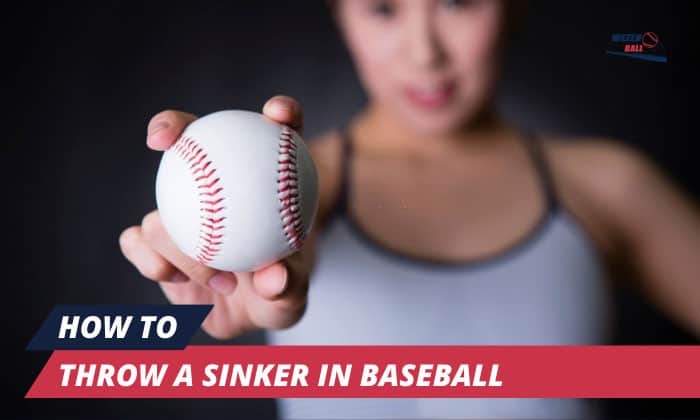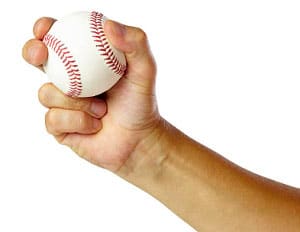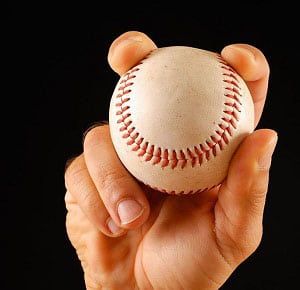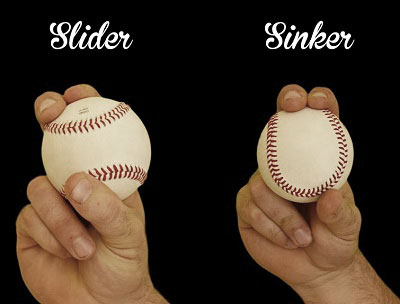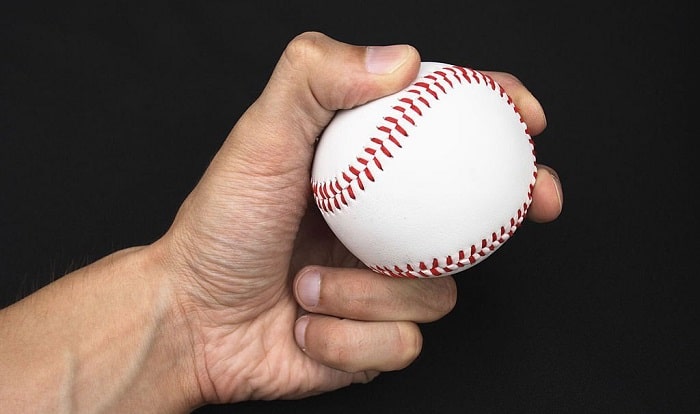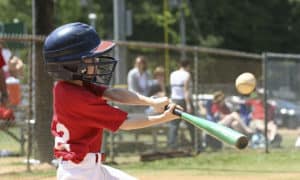One of the most coveted pitching styles in baseball is sinker or sinking fastball. What’s amazing about this pitch is that it’s easy on the am and has a deceitful trajectory.
The batter expects a straight ball, but as the ball approaches home plate, it swiftly sinks toward the ground. It’s mystifying how this pitch works, but it isn’t tough to learn.
Read on to know how to throw a sinker in baseball and some interesting facts about sinkers.
Contents
How to Throw a Sinker
Learning to pitch a sinker doesn’t have to be too challenging, here are the best tips that you can follow.
1. Find the Right Sinker Baseball Grip
- Using your dominant hand, hold the ball in a slightly outward position.
- Hook your middle and index fingers over the closest seam.
If you do not find it natural and comfortable, change the middle and index fingers a little by positioning them on the outside of the seams.
Your middle finger should rest in the middle of the ball because it’s the main pressure point when you throw the ball.
- Place your thumb directly below and between your middle and index fingers. The thumb should wrap the bottom of the ball to get a secure grip.
There are variations on how to hold a sinker. If the traditional sinker grip is uncomfortable for you, this alternative grip may work for you.
- Hook your middle and index fingers over the seam’s horseshoe.
- Place your thumb at the bottom of the ball, in between the middle and index fingers.
2. Get Into the Right Position
- Stand in your usual pitching position. Keep your upper body relaxed, knees bent, and feet and shoulder width apart. Position your body up. Your non-throwing arm should point toward the batting mound.
- Direct your throw towards the batter’s belt area. Make sure you don’t pitch above the waist of the batter as this will be an easy hit for them.
- Begin winding up. Take a step back to the second base, shifting your weight onto your back foot while bringing your knee up. Lean forward quickly and transfer your weight to your front leg as you are launching the ball to the batter.
Alternatively, assume a stretch position. Direct your feet and body toward the third base but face the home plate. Release the ball with a quick slide step or a high kick stance.
- Pivot your upper body toward the batter. Your torso should face the batter as you throw the ball. Keep your eyes on the waist level of the batter upon releasing the ball.
3. Release the ball
- Throw the ball over the top. Bring your arm forward while rotating your arm high and bring it down after throwing the ball. Be careful not to rotate the arm too much as this can lead to injury.
- Hold the ball tightly using your fingers and thumb until the moment you throw it.
- Apply high pressure to the middle finger before throwing the ball. Sidespin is derived by placing your index finger ahead of the middle finger.
- Slightly twist your hand outward as you release the ball. This is called pronation, which can facilitate horizontal movement of the ball before dropping over the home plate.
By taking a series of sinker pitching lessons, you can get the hang of it eventually. You will also know the sinker grip and release that work best for you.
Tips on How to Throw Sinkers:
Other Sinker Tips
Sinkers are tricky. There are variations in grip and release. You need to experiment and experiment until you find the sinker style that suits you perfectly.
- If you want to put side spins on your sinker pitch, make sure to place your thumb underneath your index and middle fingers up until the ball is thrown.
- Keep a tighter grip on the ball than you would on a fastball until the ball is released. This helps to cause the ball to sink over the home plate.
Watch this video of a sinker pitch slow motion and how to throw a sinker right-handed.
Reasons Why a Sinker Sinks
How is it possible for a ball that is traveling at a horizontal path to suddenly drop sharply toward the ground just as it is approaching the hitter? Here’s the answer.
- A mixture of spins helps sink the ball. Applying less pressure in the middle of the ball and more pressure in the inside edge as you release the ball from your fingertips can create fewer spins, causing a heavy sinking movement.
- A slower spin rate causes the ball to spin downwards. Sinkers don’t resist gravity as compared to fastballs with faster spins.
1. Sinker vs 2-Seam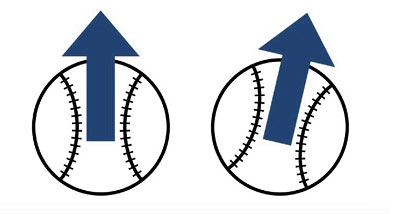
In a sinker pitch, you apply more pressure on the middle finger, but in a two-seam fastball, it’s on the index finger.
2. Sinker vs Slider
Both differ in grips and motions, but they are both great at deceiving a batter.
Sinker is a fastball variant while the slider is a type of breaking pitch. Sinker travels at a greater velocity than sliders (6 to 8 mph slower).
Sinker pitch movement follows a horizontal path, whereas sliders move sideways For right-handed pitchers, the ball moves from right to left, and for the left-handed, it moves from left to right.
FAQs
What is a sinker?
A sinker is a fastball with less spin and has a sharp downward movement. It aims to deceive the batter of the ball’s direction and cause ground balls, weak ball contacts, and limit home runs.
Why is it called a sinker pitch?
As its name implies, a sinker is a fastball that sinks as it’s about to reach home plate. The ball remains in a horizontal flight path from when it was thrown until it’s approaching the hitter. And then it suddenly dips swiftly towards the ground, either just slightly before or right on home plate.
Is a sinker hard to throw?
It depends on the pitcher’s skill level. If you’ve mastered the steps on how to throw a sinker, then it wouldn’t be tough to pull it off.
Who is the best sinker in baseball?
Ranking differs by year. In 2022, the best sinker was Dillon Tate while in 2021, it was Adrian Houser.
How do you grip a sinker?
First, a proper grip is necessary. For others, a two-seam sinker works well with them, but others find the one-seam sinker better.
In a one-seam sinker grip, your index and middle fingers should be placed on top of a single seam. Pronate slightly your fingers and hand on the inside of the ball to create a slightly tilted spin. This prevents the ball from resisting gravity and causes it to sink sharply.
Why is it hard to hit a sinker?
It’s because of its high velocity and deceptive trajectory. Batters may think that they are getting a straight fastball, but then the ball drops dramatically until the last second. Once the ball sinks, the batter might not hit the ball and end up with a ground ball.
When to throw a sinker pitch?
It depends on the pitcher and the situation.
If a pitcher is facing notorious power hitters, throwing sinkers helps induce weak contact with the balls or ground balls. It also reduces the chances of fly balls.
When there are runners on base, sinkers increase the chances of ground balls and a double play.
What are the characteristics of a perfect sinker?
A sinker should land below the waist of the batter. It should have less vertical movement than a typical fastball and must have a high velocity. It should land slightly to the inside of a hitter. Moreover, it should have less spin to cause it to sink as it progresses to the hitter’s mound.
What are the advantages of a sinker?
Sinkers are easy on the throwing arm. They keep the ball low i the strike zone, producing ground balls and whiffs.
Conclusion
A sinker should be an indispensable addition to your repertoire of pitching skills. If you’re a beginner and want to learn this pitch, follow the tips above on how to throw a sinker in baseball.
Sinkers are fastballs with sharp downward movement. They’re effective at inducing ground balls and whiffs because of their illusive trajectory. When properly executed, they can strike out power hitters and limit home runs.
With constant practice and feedback from experts, you can master sinker in the shortest possible time. You will be confident to throw a nasty sinker to leverege your team’s victory.
Furthermore, please take a look at these guides to throw a baseball faster and farther.

A powerful swing and the ball is flying across the field, just one hit, and we might never forget the thrill it brings. I do not know about you, but I never do. Every baseball game is the chance to compete with others and cooperate with your teammate. It is among my biggest passions.



